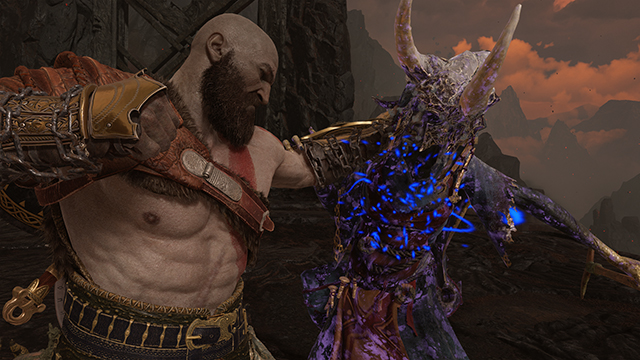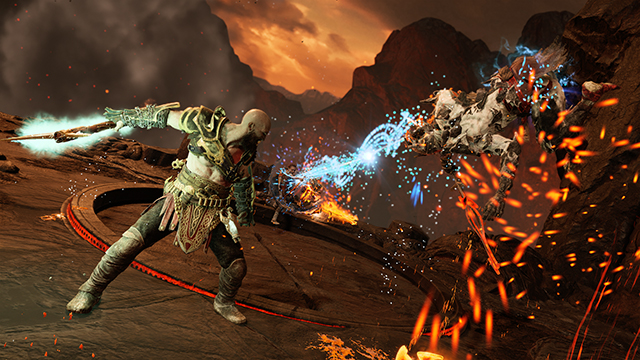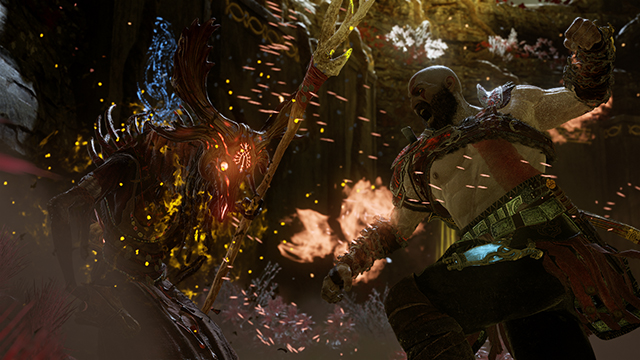To celebrate the one-year anniversary of God of War, we’ll be publishing (or republishing) some deep dives on how the Game of the Year winner came to be based on some GDC 2019 talks.
Kratos will always be known for his Blades of Chaos but the Leviathan Axe from God of War is now yet another weapon that the former god of war will forever be attached to. It had the grace, strength, and recall abilities of Thor’s Mjölnir and never stopped being a satisfying way to dismember enemies. But like Atreus and the game as a whole, it wasn’t always like that. The axe went through a ton of iteration both big and small and took a long time to go from plain, garden variety axe to a weapon fitting of a former god.
This is not an exaggeration too. Jason MacDonald, senior combat designer at Sony Santa Monica, said that the weapon was boring in its early stages and reminiscent to an axe you may find at Home Depot. But the team wouldn’t hit that issue for quite some time as it was starting out. Sony Santa Monica was still trying to figure out how to get the axe to embody three key pillars: one versus many, playful combat, and power for all. Those three categories served as the key focal points that revolved around the axe and combat as a whole and proved to be quite challenging.
Close and personal

The Blades of Chaos were made to hit multiple enemies and the axe had to be more precise. He started from there and figured that they would fix the camera problems along the way. That camera, in its rough state, meant they had to acknowledge how much harder it was to be aware of enemies in the battlefield as well, which also led to slower combat and how players would prioritize certain threats over others. It’s perfect for a deliberate axe.
In turn, this helped inform the camera and it was zoomed out just ever so slightly from that original crappy demo but still didn’t show Kratos’ full body. This ended up being, more or less, what was in the final game. The team was on to something.
However, that still left the axe. The Blades were mythical chains on fire that gave players a certain power fantasy and they tried to do that with the axe. They made his combos shorter, which made Kratos feel stronger since he was tearing through most foes in a few simple hits. The axe was even sticking inside of enemies and would need to be physically pulled out almost like chopping down a tree. It was powerful, distinct from the old titles, and more deliberate which was everything they thought they wanted.
But something still wasn’t right until an early animation previs showed Kratos throwing the axe to protect the boy. This throwaway idea was dismissed for a bit until Lead Combat Designer Vincent Napoli dropped the almighty phrase: “Why doesn’t he just recall the axe?” And like what the axe was doing the enemies, it stuck. This immediately resonated since aiming was deliberate and worked well since the camera was already similar to those of a third-person shooter. The bigger takeaway was that it was the gateway to being more mythical, which is where the axe was lacking.
This all led to the first playable demo that combined the better camera, axe throw, shorter combos, and functioning Atreus. It went terribly despite hitting the team’s goals. Players were scared to attack because it was too easy to get hit out of combos and constantly backing up and playing defensively. God of War was about pushing forward and this was the opposite of that.
MacDonald then realized that being deliberate doesn’t meant being careful and this caused them to take another wide view of the game. Through deconstructing the previous games’ combat, they were able to more easily focus on where they wanted to improve. They wanted to retain one versus many combat, playful combat, and power for all.
One versus many

Crowd control was first and it was something the Blades were incredible at. Their wide, sweeping motions hit everything in their wake. The Blades’ grounding phrase in the original God of War trilogy was “ballet of fire,” which not only described what they did but also helped the team attach to a phrase to design the weapon around. The axe not only lacked such a phrase but it just wasn’t great at attacking multiple enemies at once, hence why players were backing up a lot; they couldn’t stagger enough enemies to keep them from being threats.
So the team came up with a grounding phrase for the axe: “plow the road.” Kratos should be able to push through enemies and have them collide with each other along the way. And this worked. The arc of Kratos’ axe swing then became a half circle, staggering (or at least hitting) everything in front of him. This wider area of effect meant players would be a bit more protecting since more foes could be hit.
It was powerful since you could hit more people and it was also deliberate because you would only attack in the direction you were facing. Even though it showcased Kratos’ power, the hard embedded axe sticks that slowed down the player were also dramatically changed to the temporary pauses more or less seen in the final game. Kratos was able to plow the road more efficiently now because he wasn’t stopping every few seconds to rip out his axe from an enemy torso.
Instead of slowing Kratos down, MacDonald said the team flipped the idea and gave the axe ice properties to slow the enemies down. Doing this solved a ton of issues. It gave the axe a much needed mythical identity, another status effect to play with, more strategic depth, and a believable reason for the area of effect runic attacks; all of which helped achieve the “one versus many” power fantasy.
Playful combat

“One versus many” doesn’t quite go hand in hand with the the “playful combat” pillar. And this is where the iPhone came in. MacDonald spoke of a talk Apple gave about fluid interfaces that are designed to be interruptible. Since playful combat requires quick thinking, almost everything in the combat was designed to canceled into another move. For example, players can cancel the heavy attack with a block at almost any time, which makes for responsive combat and an offensive system that shouldn’t be risky but playful. If players could think it, they should be able to do it and canceling helped achieve that.
Playing with the enemies doesn’t stop at high priority defensive cancels; it extends to the offense too. MacDonald had to figure out why players would ever want to use the heavy attack. More damage would be too ambiguous since there were no damage numbers. Breaking blocks would be a decent addition but not if the enemy doesn’t block. A heavier enemy reaction would work but there is no gameplay benefit to doing so.
To remedy this, the team began thinking of the heavy attack button as the setup button. This allowed players to use this separate attack to launch enemies, which is inherently playful as its hard not to want to juggle foes for as long as possible. This led to other state changes like knocking them into other enemies and walls as well as tripping them or kick them out of the play area. Enemies also had more health at this point and it, combined with the new state changes, encouraged players to use the enemies as punching bags to constantly test out how they could manipulate them.
Throwing the axe was important but it wasn’t as playful until different hit reactions were added and ended up cementing how far the team had come in its “playful combat” pillar. Headshots will spin the enemy around, a leg shot would trip them up, and a charged heavy shot would freeze one unlucky foe in place, and all of them let players choose different setups. They gave players more time to strategize and open the door for improvization, which is at the heart of it all. Playing around with the moveset and enemies let players create combos that were not canned, which is a key factor in making good combat.
Power for all

The combat against many enemies was now playful but Sony Santa Monica had to figure out how to allow everyone to feel powerful. Rage meters in the past God of War games did this as they allowed players to make a comeback and it made sense to bring this mechanic back. And like the axe, the Rage mode needed a phrase: “monster out of the box.”
Kratos was supposed to unleash the monster we all knew he had inside but this also let the team dip back into that old God of War feel. Attacks are less deliberate in this mode and not only give players a Get Out of Jail Free card, but also injected some frenzy in the deliberate axe gameplay. While not as complex as an issue as making the combat more playful, it still was important to remember that everyone should at least feel powerful and the Rage mode was the way to accomplish that.
The axe was only one axepect aspect of the combat. Sony Santa Monica had to figure out how grabbing would work, whether or not to implement a stamina system, how Atreus could feasibly help a literal god of war, and many other tough questions that were seemingly uprooting everything that came before.
But the axe was the linchpin of the whole game as it was symbolic of the series’ new territory and direction. Kratos’ new toy had to simultaneously live up to the iconic Blades of Chaos yet also be different enough to facilitate the game’s new direction. The tall task was ultimately successful given that the two weapons sit by side in the latter half and are both equally viable tools of destruction that harmoniously work together to create a deep and rewarding combat system.







